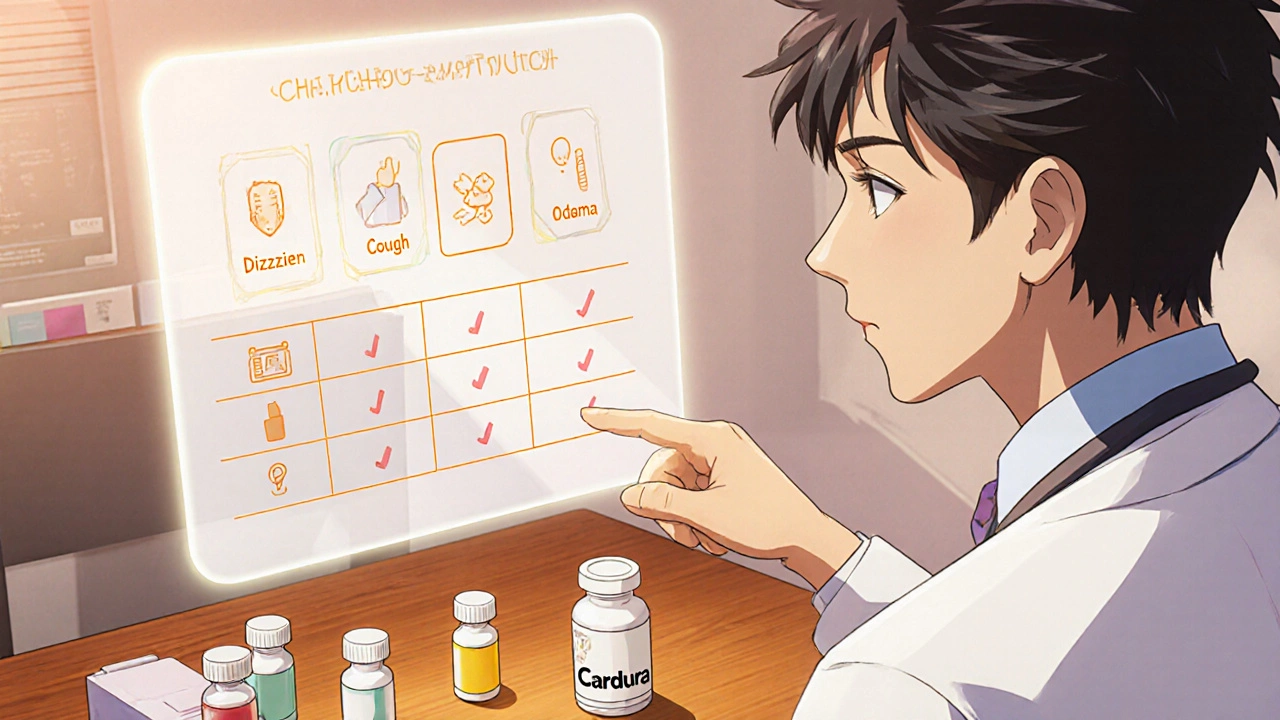Medication Matchmaker: Compare Blood Pressure & BPH Treatments
Find Your Best Match
Answer these questions to see how Cardura compares to alternatives based on your health profile.
Your Primary Concern
Side Effect Tolerance
Health Considerations
Cost Sensitivity
Your Recommended Match
Pros
Considerations
Cost Comparison
When treating high blood pressure or an enlarged prostate, Cardura (doxazosin) is often mentioned as a go‑to option. But is it really the best fit for you? This guide walks through how doxazosin stacks up against other widely used drugs, from other alpha‑blockers to ACE inhibitors and calcium‑channel blockers. By the end you’ll know when Cardura shines, where it falls short, and which alternative might suit your health profile better.
What is Cardura (Doxazosin)?
Doxazosin is an oral alpha‑1 adrenergic blocker that relaxes smooth muscle in blood vessels and the prostate. Approved by the FDA in 1995, it carries the brand name Cardura and is prescribed for two main reasons: lowering blood pressure (hypertension) and easing urinary symptoms caused by benign prostatic hyperplasia (BPH).
Key attributes of doxazosin include:
- Mechanism: blocks alpha‑1 receptors, preventing norepinephrine‑induced vasoconstriction.
- Typical dose for hypertension: 1-8 mg once daily.
- Typical dose for BPH: 1-8 mg once daily, often starting low to avoid a sudden drop in blood pressure.
- Half‑life: roughly 22 hours, allowing once‑daily dosing.
- Common side effects: dizziness, headache, fatigue, and sometimes first‑dose hypotension.
Why Look at Alternatives?
No single medication works for everyone. Genetics, age, other health conditions, and even lifestyle factors can affect how well a drug performs. Some patients experience intolerable dizziness with doxazosin, while others need stronger blood‑pressure control than an alpha‑blocker can provide. Knowing the trade‑offs helps you and your clinician decide whether to stay with Cardura or switch to another class.
Major Drug Classes to Compare
Below are the most common groups that clinicians reach for when treating hypertension or BPH:
- Other alpha‑blockers (e.g., Terazosin, Prazosin)
- ACE inhibitors (e.g., Lisinopril)
- Calcium‑channel blockers (e.g., Amlodipine)
- Angiotensin II receptor blockers - ARBs (e.g., Losartan)
- Beta‑blockers (e.g., Metoprolol) - primarily for heart‑related issues but sometimes used for blood‑pressure control.
Each class has a distinct mechanism, dosing schedule, side‑effect profile, and cost. The comparison table that follows focuses on the five most frequently prescribed alternatives.
| Drug | Class | Primary Indication | Mechanism | Typical Daily Dose | Half‑life | Common Side Effects | Average US Monthly Cost* |
|---|---|---|---|---|---|---|---|
| Doxazosin (Cardura) | Alpha‑1 blocker | Hypertension, BPH | Blocks alpha‑1 receptors → vasodilation & prostate smooth‑muscle relaxation | 1-8 mg | ≈22 h | Dizziness, headache, first‑dose hypotension | $30‑$45 (generic) |
| Terazosin | Alpha‑1 blocker | Hypertension, BPH | Same as doxazosin - blocks alpha‑1 receptors | 1-10 mg | ≈12 h | Dizziness, edema, nasal congestion | $20‑$35 (generic) |
| Lisinopril | ACE inhibitor | Hypertension, heart failure | Inhibits conversion of angiotensin I to II → vasodilation | 10-40 mg | ≈12 h | Cough, hyperkalemia, rare angioedema | $15‑$25 (generic) |
| Amlodipine | Calcium‑channel blocker | Hypertension, angina | Blocks L‑type calcium channels → smooth‑muscle relaxation | 2.5-10 mg | ≈30-50 h | Peripheral edema, flushing, dizziness | $10‑$20 (generic) |
| Losartan | ARB | Hypertension, diabetic nephropathy | Blocks angiotensin II receptors → vasodilation | 50‑100 mg | ≈2 h (active metabolite 6‑9 h) | Dizziness, hyperkalemia, rare cough | $20‑$30 (generic) |
*Costs reflect average retail prices for a 30‑day supply of the generic form in 2025 and can vary by pharmacy.

How to Choose the Right Medication for You
Picking a drug isn’t just about the numbers in a table. Consider these practical decision points:
- Primary health goal: If BPH relief is the main concern, an alpha‑blocker like Cardura or Terazosin usually wins because it tackles prostate smooth‑muscle directly. For pure blood‑pressure control, ACE inhibitors or ARBs often achieve lower systolic numbers with fewer reflex tachycardia issues.
- Side‑effect tolerance: A chronic cough can be a deal‑breaker for ACE inhibitors; if you’ve already experienced that, an ARB (Losartan) or a calcium‑channel blocker (Amlodipine) might be kinder.
- Kidney function: Doxazosin is safe in mild‑to‑moderate renal impairment. Lisinopril, however, needs dose adjustment when eGFR falls below 30 mL/min/1.73 m².
- Drug interactions: Doxazosin is metabolized by CYP3A4, so strong inhibitors (e.g., ketoconazole) can raise its levels. Amlodipine also uses CYP3A4, while lisinopril is cleared unchanged - making it a quieter option when you’re on multiple meds.
- Cost and insurance coverage: Generic Cardura is affordable, but some plans favor ACE inhibitors or ARBs due to formulary tiers. Check your pharmacy benefits before deciding.
Special Populations and Adjustments
Different groups need specific tweaks:
- Elderly patients: First‑dose hypotension is more common with alpha‑blockers. Starting at 0.5 mg and monitoring blood pressure for 2 hours post‑dose can prevent falls.
- Patients with diabetes: ARBs like Losartan protect kidney function, making them a frequent choice when both hypertension and diabetic nephropathy coexist.
- Pregnant women: ACE inhibitors (lisinopril) and ARBs (losartan) are contraindicated. Methyldopa or labetalol are preferred; alpha‑blockers are used only when benefits outweigh fetal risks.
- Those on multiple antihypertensives: Combining an alpha‑blocker with a diuretic can improve blood‑pressure control, but beware of additive dizziness.

Potential Pitfalls When Switching from Cardura
Moving away from doxazosin isn’t as simple as swapping pills. Here are common hiccups and how to avoid them:
- Rebound hypertension: Abruptly stopping Cardura can cause a sudden rise in blood pressure. Taper the dose over 1-2 weeks while introducing the new agent.
- Unmasking BPH symptoms: If you were using doxazosin for prostate relief, switching to a drug that doesn’t address BPH (like lisinopril) may bring back urinary urgency. Consider adding a 5‑alpha‑reductase inhibitor (e.g., finasteride) if BPH remains a concern.
- Drug‑specific side‑effects: ARBs may cause mild hyperkalemia, while calcium‑channel blockers can lead to ankle swelling. Monitor labs and physical signs after the switch.
Practical Tips for Working with Your Provider
Bring these questions to your next appointment:
- What is my main treatment goal - lower blood pressure, relieve urinary symptoms, or both?
- Are there any current meds that could interact with an alpha‑blocker?
- Will my insurance cover the alternative I’m considering?
- How should we monitor for side effects (e.g., blood pressure checks, kidney labs)?
Having clear answers helps your clinician tailor a regimen that fits your lifestyle and health profile.
Bottom Line Summary
If you need a dual‑action drug that tackles both hypertension and BPH, Cardura remains a solid, cost‑effective choice, especially when you can start low and go slow to avoid first‑dose drops. For patients who can’t tolerate its dizziness, or who need stricter blood‑pressure targets, switching to an ACE inhibitor, ARB, or calcium‑channel blocker often yields smoother control with fewer orthostatic symptoms. Always weigh side‑effects, kidney function, and insurance coverage before making a change.
Can Cardura be used alone for high blood pressure?
Yes, Cardura works as a monotherapy for many patients with mild to moderate hypertension. Its once‑daily dosing and long half‑life make it convenient, but doctors often pair it with a thiazide diuretic if the blood pressure goal isn’t met.
What’s the biggest difference between doxazosin and terazosin?
Both are alpha‑1 blockers, but terazosin has a shorter half‑life (≈12 h) and may require twice‑daily dosing for consistent blood‑pressure control. Doxazosin’s longer half‑life lets most patients stay on a single daily dose.
Why do some people develop a cough with lisinopril?
Lisinopril inhibits ACE, which also breaks down bradykinin. Elevated bradykinin in the lungs can trigger a dry, persistent cough. Switching to an ARB like losartan bypasses this pathway.
Is it safe to take Cardura with a calcium‑channel blocker?
Yes, the combination is often prescribed. They act on different pathways - alpha‑blockade vs. calcium‑channel inhibition - providing additive blood‑pressure lowering without major pharmacokinetic clashes. Monitor for excessive dizziness.
How quickly does Cardura improve urinary symptoms?
Patients usually notice smoother urine flow within 1-2 weeks, with maximum benefit around 4-6 weeks as the prostate muscle relaxes fully.




Abhinav B.
October 25, 2025 at 14:48Doxazosin is a solid pick for many Indian patients because the generic price fits our tight budgets, and the once‑daily dosing suits our busy lifestyles. The drug’s long half‑life means you don't have to remember multiple pills a day, which is a blessing in crowded households. First‑dose hypotension can be a real scare, so I always tell my fam to start with the half‑mg tablet and sit down for a while. It works well for both hypertension and BPH, so you kill two birds with one shot – a real money‑saver. Just watch out for that dizziness; it's common and can trip you up on uneven roads. Overall, Cardura gives good value in the Indian market, especially when insurance coverage is limited.
Abby W
October 25, 2025 at 15:46Wow, that breakdown is super helpful! 🙌 The way you compared the half‑lives makes it crystal clear which drug fits a hectic schedule. I love the emoji vibe here 😆 and the friendly tone keeps it from feeling like a textbook. Also, kudos for mentioning the cost aspect – that's the real talk we need.
Lisa Woodcock
October 25, 2025 at 18:33Reading this felt like a warm chat over chai – you really covered the cultural angle of medication access, and I appreciate the empathy toward patients juggling multiple conditions. The table is a gold mine for anyone trying to compare side‑effects without getting lost in jargon. It’s great to see a balanced view that doesn’t push a single drug as the “only answer.” Thanks for keeping it inclusive and practical.
Melanie Vargas
October 25, 2025 at 19:56Exactly! 🌟 It’s refreshing to see a post that’s both data‑driven and patient‑centric. The side‑effect profiles are laid out nicely, making it easier to discuss options with a doctor. And yes, a little emoji never hurts to brighten the read! 😊
Deborah Galloway
October 25, 2025 at 21:20I totally agree – the practical tips about tapering off Cardura are invaluable. It’s easy to overlook the rebound hypertension risk when switching meds. Your suggestion to monitor labs and watch for BPH symptom return shows true patient‑first thinking. Thanks for the friendly, thorough guide!
Charlie Stillwell
October 26, 2025 at 00:06Let's cut through the fluff and get to the nitty‑gritty of pharmacodynamics here. Doxazosin, an alpha‑1 antagonist, leverages vasodilation via sympathetic blockade, a mechanism that, while elegant, invites orthostatic hypotension in a non‑negligible cohort. Contrast that with ACE inhibitors, which modulate the renin‑angiotensin system-a pathway offering superior afterload reduction without the reflex tachycardia seen in alpha‑blockade. Moreover, the pharmacokinetic profile of Cardura, boasting a 22‑hour half‑life, is a double‑edged sword; it ensures steady‑state concentrations but also prolongs adverse events. The table you provided highlights this dichotomy starkly, especially when juxtaposed with the 12‑hour half‑life of terazosin, which affords more titratable dosing. From a cost‑effectiveness standpoint, generics hover around $30‑$45 per month, a respectable figure, yet hidden costs arise from falls and emergency visits precipitated by dizziness. In geriatric populations, the first‑dose phenomenon is not a mere inconvenience but a potential morbidity trigger. While calcium‑channel blockers like amlodipine present a more benign side‑effect spectrum, they introduce peripheral edema, another quality‑of‑life compromise. The ARB class, exemplified by losartan, sidesteps the infamous ACE‑inhibitor cough yet carries hyperkalemia risks, especially in renal impairment. It is imperative to align drug selection with comorbidities; for instance, diabetic nephropathy patients gain renoprotective benefits from ARBs over alpha‑blockers. Additionally, drug‑drug interactions merit attention: CYP3A4 inhibitors can elevate doxazosin levels, an interaction not shared by the primarily renally excreted lisinopril. In clinical practice, polypharmacy necessitates such granular awareness. Ultimately, the decision matrix is not a simple cost‑vs‑efficacy calculation but a multidimensional assessment encompassing pharmacology, patient adherence, safety profile, and systemic healthcare economics.
Ken Dany Poquiz Bocanegra
October 26, 2025 at 02:53The side‑effect profile is the real deal‑breaker for many.
krishna chegireddy
October 26, 2025 at 04:40Everyone’s raving about Cardura like it’s the silver bullet, but have you considered that the pharma giants are pushing it to lock us into a lifelong dependency? The half‑life is long, sure, but that also means the drug hangs around in your system, keeping the market hungry for newer, more expensive alternatives. It’s a classic trap – you think you’re getting convenience, but you’re actually signing a contract with the industry. Look at the table: the cost isn’t astronomical, yet the hidden expenses of monitoring and managing dizziness add up. Don’t be fooled by the glossy marketing; there’s a whole world of cheaper, effective options that get ignored.
Tamara Schäfer
October 26, 2025 at 06:03I love how the post breaks down the pros and cons – super helpful for anyone feeling overwhelmed. Just a tiny tip: keep an eye on your electrolytes when switching to an ARB, especially if you have a mild kidney issue. Also, remember that sometimes a combo – say, a low‑dose diuretic with Cardura – can smooth out the blood‑pressure peaks without upping the dizziness risk. Good luck! :)
Tamara Tioran-Harrison
October 26, 2025 at 07:26Ah, the ever‑so‑informed “guide” that pretends to be impartial while subtly nudging you toward a specific pill – how delightfully predictable. One must applaud the exhaustive table; however, the omission of long‑term adherence data is a glaring oversight, isn't it? Nevertheless, the polished prose and immaculate formatting certainly elevate the reading experience. 😐